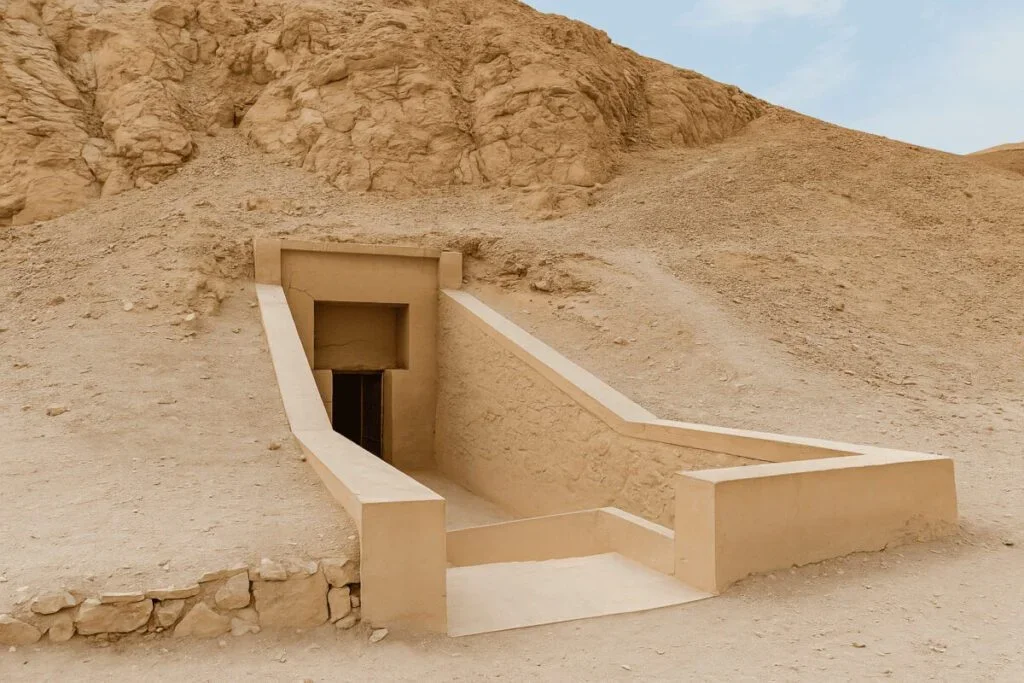Discovering Ancient Egypt in Asheville
King Tut Comes to Biltmore Estate
Now Through January 4, 2026
In 1978, my parents took me to the Los Angeles County Museum of Art for one of my most memorable childhood experiences – Treasures of Tutankhamun. I was only seven years old at the time, yet the memory remains vivid in my mind. After waiting in long lines filled with excitement and anticipation, our turn finally came. The moment we stepped inside, my lifelong fascination with ancient Egypt began.
Nearly 47 years later, I had the joy of reliving that memory with my sister at Tutankhamun: His Tomb and His Treasures, an extraordinary exhibition at the Biltmore in Asheville, North Carolina - an exhibit running now through January 4, 2026.
The Tutankahmun exhibit at the Biltmore is an awe-inspiring journey into one of history’s most fascinating discoveries. What makes it so remarkable is how it brings ancient Egypt to life through stunningly detailed reconstructions of Tutankhamun’s tomb, the nesting chambers, the iconic golden funerary mask, and priceless treasures found within as well as the Vanderbilt/Cecil family’s personal connections to its original discovery.
Visitors are immersed into the story of the discovery of the tomb of the “Boy King,” only 9 years old when he came to rule, combining artistry, archaeology, and ancient history in a way that transports you back 3,000 years in time to Egypt’s golden age.
TABLE OF CONTENTS
HISTORY OF THE DISCOVERY OF KING TUT
Howard Carter’s discovery of Tutankhamun’s tomb in 1922, was groundbreaking and perhaps the greatest archaeological story every told. It was the first and only time a tomb had been located in the Valley of the Kings almost completely intact, undisturbed since its sealing over 3,000 years ago. However, the story of its discovery was so much more. It was a story of passion, perserverance, and real life adventure.
In the early 1900s, Howard Carter, a British archaeologist, had become convinced that the young pharoah’s royal tomb remained hidden in the Valley of The Kings, still waiting to be discovered. After almost seven years of tirelessly combing the desert, fruitlessly searching for it, his wealthy patron Lord Carnarvon was close to pulling funding and those around him grew skeptical. However, Carter remained steadfast, convinced he could find it. He persauded Carnarvon to finance him for just one more final season of searching - a decision that changed history forever. On November 4, 1922, Carter’s team uncovered a single step. With further excavation, a series of steps was revealed which led down to a buried, sealed doorway near the tomb of Ramses VI - a doorway bearing a royal insignia stamped on it.
With a chisel, Carter began chipping away at the top left corner of the door until he created a hole large enough to hold a candle through so he could peer inside. As the candle flame steadied, legend has it that Carter excitedly announced that he could see a room full of “wonderful things!” Behind that door was the discovery of a lifetime - the nearly intact tomb of the “Boy King” filled with treasures beyond anyone’s wildest imagination, over 5,000 artificats including the infamous golden death mask, chariots, furniture, weapons, and the nesting shrines holding the sarcophagus in which the mummy of King Tut lay.
When visiting Biltmore, you truly feel as if you’re right there with Carter making this astonishing discovery. Before entering, visitors watch a short film. As the story unfolds, you see Carter tirelessly searching, the growing doubt and near misses - until finally, that step leading to the buried doorway is uncovered. You see Carter chiseling away at the door, peering in with the candle and suddenly, the films stops right as Carter is about to enter the chamber. The door opens to the Biltmore exhibit. As you step through the door, something magical happens. It’s as if you’re actually walking into his discovery, everything set up exactly as Carter found it, each artifact carefully displayed precisely where it was nearly 3,000 years ago.
The sensation is chilling and awe-inspiring as if you are the one discovering it, the first to witness the ancient wonder like Carter did all those years ago.
TIPS FOR VISITING
If you’re planning to visit the Tutankhamun exhibit at Biltmore, here are a few things to know before you go to make the most of your experience.
The exhibit will be on display through January 4, 2026, at Amherst at Deerpark on Biltmore Estate.
Deerpark is located about 3 miles from Biltmore House. Allow 30-45 minutes to drive there from other locations on the property.
Plan on arriving early. Tickets are timed entry. If you are running late, you may be denied entry especially if you are the last time slot of the day.
There is ample parking at Deerpark.
Your ticket to the exhibition includes a second day of access to the estate grounds.
Plan on spending at least 2 hours at the exhibition.
If you want to tour the mansion, I suggest doing so on a separate day. Although it is completely do-able to see everything in a single day, it’s a lot to take in.
Wear comfortable walking shoes.
Discounted exhibition-only admission tickets and discounted estate admission for guests (includes Biltmore House access) are avaialle for annual passholders via the Passholder dashboard.
Biltmore uses staggered entry times to keep the crowds smaller so guests can enjoy the exhibit. With that said, the least crowded times to visit are weekday mornings.
Cell phone photography and non-flash photography are allowed for personal use. Tripods, selfie sticks, GoPros, and other equipment are prohibited.
Large bags are not allowed but there are a limited number of lockers you can rent.
The exhibit is ADA accessible. There is limited seating available inside the exhibit and there are a limited number of ADA parking spots.
The exhibit is family-friendly.
Engaging and informative audio guides are available to all visitors with a special kid friendly version.
It is importnat to know that you will be seeing replicas of the artifacts. The originals are too fragile to travel and are now rightfully the property of Egypt. While some of the treasures have traveled internationally in the past, the originals are now being permanently housed in the newly constructed Grand Egyptian Museum in Giza to preserve their history and ensure locals have access to their cultural heritage. Regardless, the replicas are meticulouslly crafted by expert Egyptian craftsmen using almost identical materials as the originals, true-to-life designs, displayed exactly how Howard Carter discovered them making it an authentic experience that is absolutely worth seeing. You will not be disappointed.
THE EXHIBIT
Tutankhamun: His Tomb and His Treasures allows you to step inside an extraordinary real life recreation of the excavation site where you can marvel at the legendary nesting shrines, the iconic golden funeral mask, and meticulously crafted replicas of treasures, displayed exactly how they appeared at the moment Carter discovered them back in 1922.
One of the main highlights of the exhibit is undoubtedley the nesting shrines that once enclosed King Tutankhamun’s sarcophagus. Much like Russian nesting dolls, the shrines were placed one inside the other. In ancient Egypt, these sacred shrines served to protect the mummy, shielding it and guiding it safely through its perilous journey to the afterlife.
King Tut’s nesting shrines consist of four gilded, rectangular wooden shrines, each nested within a larger one, safeguarding the sarcophagus that held the king’s mummy. The innermost shrine contained a large quartzite sarcophagus. The increasing richness of the materials in each successive layer reflected the pharaoh’s elevated status. The scenes and spells adorrning the shrines were drawn from texts like the Book of the Dead intended to provide the knowledge and assistance needed to navigate the underworld and achieve eternal life.
Another highlight of the exhibit is the iconic gold funerary mask of Tutankhamun, arguably the most famous death mask in the world due to its anicent origins, beauty, and historical significance. Anicent Egyptians used funerary masks to give a face to the deceased so that their soul would recognize the mummified body upon returning to it after death, and to guard the deceased from evil spirits during the journey to the afterlife.
King Tut's mask is made of two layers of high caret gold and weighs almost 23 pounds. It is inlaid with semi-precious stones including a bright blue stone called lapis lazuli for the eyebrows and eye surrounds, quartz for the eyes, and obsidian for the pupils. The collar and headress are made of colored glass and other stones like carnelian, feldspar and turquoise. Just the gold content alone is estimated to be worth over a half million dollars based solely on weight, although the mask itself is priceless.
A set of four canopic jars (ancient urns) served as vessels that held the pharoah’s internal organs during mummification - the liver, lungs, stomach and intestines. Each jar was carved from a single block of alabaster, with lids shaped like human heads in the king’s image. The jars sat facing each other inside a canopic chest placed inside a gilded wooden shrine. At each of the four corners of the shrine are carved figures of the godesses Isis, Nephthys, Neith and Selket with arms oustretched around the chest as if protecting its contents. The jars were believed to protect the pharoah’s organs on the journey to eternity.
What’s unusual about these canopic jars is that inside each one was a miniature solid gold coffin holding the conents that mirrored the pharoah’s own coffin. Something that was not common and signifies the young king’s extraordinary importance.
Other highlights:
Life-size recreation of the tomb chambers arranged to replicate its appearance when it was discovered by Howard Carter.
Ornate chariots that would have been used by the pharoah for sport, ceremony, or warfare.
Richly decorated furniture including the golden throne - wood overlaid with gold foil, semi-precious stones, and glaze depicting Tutankhamun and his wife Ankhesenamun.
Statues of gods, protective figures, and King Tut himself.
Wall paintings and murals.
Gaming boards including “senet,” a popular game in Ancient Egypt with religious significance, symbolizing the journey of the soul through the afterlife.
A bust that was used to display and prepare the king’s garments and jewelry along with jewelry, garments, and sandals.
Painted chest and boxes that contained textiles and valuables.
Daily objects, ritual objects, weapons, decorative fans, and other items for use in the afterlife.
TIES TO BILTMORE ESTATE
The King Tut exhibit has a fascinating and unexpected connection to the Biltmore Estate, making it an especially meaningful place to experience it. Not only did George and Edith Vanderbilt visit Egypt on several occasions - a very fashionable thing to do in their day - but the ties run even deeper through their daughter Cornelia who married the Honorable John Francis Amherst Cecil. The Cecil family were close friends of Howard Carter.
In fact, John Cecil’s mother, Mary “May” Rothes Tyssen-Amherst Cecil, helped to foster Carter’s early interests in Egypt, interests that led to his extraordinary discovery of King Tut.
May had been fascinated by Egypt since childhood which led her to visit many times and even lead her own excavations there. Her travel journals and watercolor paintings from those travels are preserved in the Biltmore’s archival collection and can be seen on display at the exhibition.
READ MORE:
Timeless Elegance - A Guide to Exploring Biltmore Estate’s Enduring Beauty
The Embers - A Hidden Gem in the Blue Ridge Mountains (Blowing Rock, North Carolina)
Quick Guide to Music City - A Dozen Things to Do in Nashville
Bolt Farm Treehouse - A Treehouse Unlike Any Other
Escape Your Concrete Jungle for a Secluded Tennessee Treehouse Getaway

































